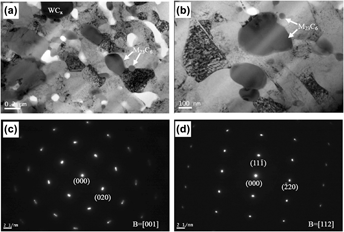Crossref Citations
This article has been cited by the following publications. This list is generated based on data provided by
Crossref.
NAGAOKA, Toru
KIMOTO, Yoshihisa
FUKUSUMI, Masao
MORISADA, Yoshiaki
and
FUJII, Hidetoshi
2015.
Modification of High-Hardness Coating Layer by Friction Stir Processing.
Journal of Smart Processing,
Vol. 4,
Issue. 3,
p.
153.
Wang, Kaiming
Chang, Baohua
Chen, Jiongshen
Fu, Hanguang
Lin, Yinghua
and
Lei, Yongping
2017.
Effect of Molybdenum on the Microstructures and Properties of Stainless Steel Coatings by Laser Cladding.
Applied Sciences,
Vol. 7,
Issue. 10,
p.
1065.
Li, Ruidi
Wang, Minbo
Yuan, Tiechui
Song, Bo
and
Shi, Yusheng
2017.
Microstructural Modification of Laser-Deposited High-Entropy CrFeCoNiMoWC Alloy by Friction Stir Processing: Nanograin Formation and Deformation Mechanism.
Metallurgical and Materials Transactions A,
Vol. 48,
Issue. 2,
p.
841.
Zhang, Bowen
Zhou, Liucheng
Sun, Yu
He, Weifeng
and
Chen, Yazhou
2018.
Molecular dynamics simulation of crack growth in pure titanium under uniaxial tension.
Molecular Simulation,
Vol. 44,
Issue. 15,
p.
1252.
Niu, Pengda
Li, Ruidi
Yuan, Tiechui
Wang, Minbo
Xie, Siyao
and
Wu, Hong
2018.
Laser solid forming assisted by friction stir processing for preparation of Ni–16Cr–8Fe alloys: Crack repairing and grain refinement.
Journal of Materials Research,
Vol. 33,
Issue. 20,
p.
3521.
Yang, Xudong
Li, Chuanwei
Zhang, Ziyang
Zhang, Xinyu
and
Gu, Jianfeng
2020.
Effect of cobalt-based coating microstructure on the thermal fatigue performance of AISI H13 hot work die steel.
Applied Surface Science,
Vol. 521,
Issue. ,
p.
146360.
Amanov, Auezhan
2020.
A promising post-additive manufacturing surface modification for tailoring gradient nanostructure and harmonic structure in Co–Cr–Mo alloy.
Vacuum,
Vol. 182,
Issue. ,
p.
109702.
Song, Boxue
Yu, Tianbiao
Jiang, Xingyu
Xi, Wenchao
and
Lin, Xiaoli
2020.
Effect of W content on the microstructure and properties of Cu-Fe alloy.
Journal of Materials Research and Technology,
Vol. 9,
Issue. 3,
p.
6464.
Sun, Yixuan
Gu, Dongdong
Dai, Donghua
Guo, Meng
Ge, Qing
Shi, Xinyu
Li, Yanze
Le, Guomin
and
Yao, Mingxuan
2020.
Thermal behavior and microstructure evolution mechanism of W-20%Fe alloy fabricated by laser metal deposition.
International Journal of Mechanical Sciences,
Vol. 183,
Issue. ,
p.
105772.
Kumar Srivastava, Ashish
Kumar, Nilesh
and
Rai Dixit, Amit
2021.
Friction stir additive manufacturing – An innovative tool to enhance mechanical and microstructural properties.
Materials Science and Engineering: B,
Vol. 263,
Issue. ,
p.
114832.
Ranjan, Rajeev
and
Das, Anil Kumar
2022.
Enhancement of mechanical and corrosion protection properties of different substrates after friction surfacing: A concise review.
Materials Today: Proceedings,
Vol. 57,
Issue. ,
p.
2111.
Rao, Srikrishna Bhaskar
Venkadeshwaran, K.
and
Shivaprasad, Y. Naidu
2023.
Research and Development Status of Laser Cladding on Stainless Steel Alloys: A Review.
Materials Science Forum,
Vol. 1110,
Issue. ,
p.
35.
